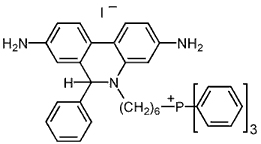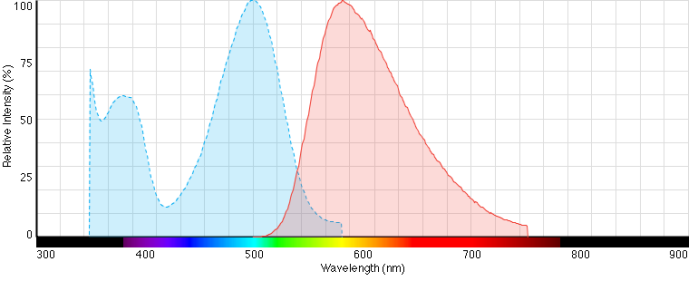Difference between revisions of "MitoSOX"
From Bioblast
| Line 1: | Line 1: | ||
{{MitoPedia | {{MitoPedia | ||
|description='''MitoSOX<sup>TM</sup>''' is the version of the hydroetidine design to target mitochondria in live cells for the detection of [[superoxide]] (O<sub>2</sub><sup>•-</sup>). The oxidation of the compund by O<sub>2</sub><sup>•-</sup> is easily detected in the red spectrum. One of the advantages of MitoSOX<sup>TM</sup> is its selectivity for O<sub>2</sub><sup>•-</sup> but not for other [[Reactive oxygen species]] or [[Reactive nitrogen species]]. | |description='''MitoSOX<sup>TM</sup>''' is the version of the hydroetidine design to target mitochondria in live cells for the detection of [[superoxide]] (O<sub>2</sub><sup>•-</sup>). The oxidation of the compund by O<sub>2</sub><sup>•-</sup> is easily detected in the red spectrum. One of the advantages of MitoSOX<sup>TM</sup> is its selectivity for O<sub>2</sub><sup>•-</sup> but not for other [[Reactive oxygen species|reactive oxygen species]] or [[Reactive nitrogen species|reactive nitrogen species]]. | ||
::::• Readily '''oxidized by superoxide''' but not by other ROS- or RNS-generating systems | ::::• Readily '''oxidized by superoxide''' but not by other ROS- or RNS-generating systems | ||
::::• '''Absorption/emission maxima''': ~510/580 nm | ::::• '''Absorption/emission maxima''': ~510/580 nm | ||
Revision as of 12:06, 3 August 2020
Description
MitoSOXTM is the version of the hydroetidine design to target mitochondria in live cells for the detection of superoxide (O2•-). The oxidation of the compund by O2•- is easily detected in the red spectrum. One of the advantages of MitoSOXTM is its selectivity for O2•- but not for other reactive oxygen species or reactive nitrogen species.
- • Readily oxidized by superoxide but not by other ROS- or RNS-generating systems
- • Absorption/emission maxima: ~510/580 nm
- • Use for live cell imaging
- • Rapidly and selectively targeted to the mitochondria
MitoSOXTM has been widely used in life cell imaging but it is not free of problems and should be used cautiously. For example, it has been highlighted that the use of potentiometric dyes which accumulates into the mitochondria due to its moiety with Tetraphenylphosphonium, confers a membrane potential sensitivity that creates a series of artifacts and problems not often considered.
Structure & Spectrum
References
Zielonka 2010 Free Radic Biol Med Polster 2014 Methods Enzymol


